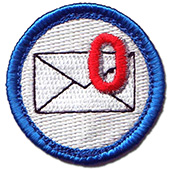Inbox Zero: Is it Worth the Effort?
A cluttered email box can be as distracting as a cluttered office. One way to tame the email beast: “delete, delegate, respond, defer or do” each time you open a message.
Topics
Social Business
Late December is a time of spring cleaning for many people, and that can mean clearing out the Email inbox: weed out messages that no longer need action, reply to ones that have been hanging around, file others to reference later.
For some people, though, striving for a perpetual state of an empty inbox is an ongoing habit or at least an ongoing effort.
“For me, Inbox Zero is a coping mechanism for the anxiety created by a constant flux of e-mail,” writes Silvia Killingsworth in “Zero Dark Inbox” on the New Yorker blog. “On the one hand, it feels great not to linger on past conversations; but on the other hand, I forget whole interactions as soon as they’re gone from my screen. I’ve traded short-term memory for a Googleable inbox.”
Killingsworth credits the “inbox zero” idea to Merlin Mann, a blogger whose 43folders.com website is “about finding the time and attention to do your best creative work.” Mann gave a Google Tech Talk about Inbox Zero back in 2007 which set out the language still used by many today to talk about the habit.
Mann “breaks every decision about what to do when faced with an e-mail into five possibilities: delete, delegate, respond, defer, do,” Killingsworth explains. Processing email efficiently has an ultimate goal, Mann says, of processing it down to zero.
Mann offers some great advice at his website (although, as he warns on his About page, “Please do not use 43 Folders as an excuse to procrastinate. That would be so ironically unwholesome as to stagger the mind.”).
One of his more popular posts covers the art of writing sensible email messages. The four biggest takeaways of that post: first, be clear about whether the purpose of the email is to provide information, request information or request action. Second, get that purpose right in the first sentence. Third, make the subject line work for you (two of his examples: “Lunch resched to Friday @ 1pm” and “Thanks for the new liver–works great!”). And fourth, be brief and make sure the message fits on “one screen with no scrolling.”
The main point: you don’t have to be a slave to your inbox. True, while it’s good to be succinct and good to process as efficiently as possible, there”s only so much most of us can do to tame the email beast. Killingsworth concedes that “In some ways, the Inbox Zero system is just a game of whack-a-mail ” as soon as you reply and archive one thread, up pops another.” But acting and filing can be liberating. And you might want to follow the lead of some people and take an email fast whenever possible, either regularly throughout the day or over an entire weekend” if you can stand it.






Comments (4)
Productive Physician
Joseph Lalonde
hughkhan@yahoo.com
Alain_o